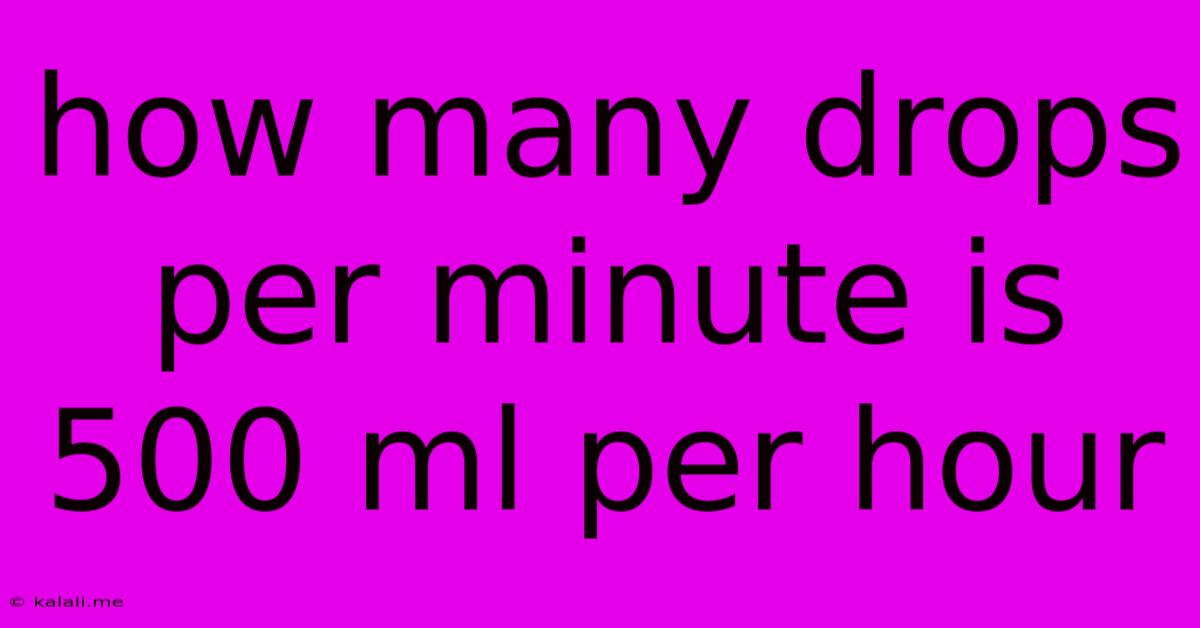How Many Drops Per Minute Is 500 Ml Per Hour
Kalali
Jun 15, 2025 · 3 min read

Table of Contents
How Many Drops Per Minute is 500 ml Per Hour? A Comprehensive Guide
Meta Description: Confused about converting 500 ml per hour to drops per minute? This guide provides a clear, step-by-step calculation, explaining the process and addressing common misconceptions. Learn how to accurately calculate IV drip rates.
Infusion rates are critical in healthcare, especially when administering intravenous (IV) fluids. Converting units like milliliters per hour (ml/hr) to drops per minute (gtts/min) is a common calculation nurses and other medical professionals must perform regularly. This article will explain how to calculate how many drops per minute are equivalent to 500 ml per hour, and provide you with the knowledge to perform similar calculations yourself. Understanding this conversion is crucial for safe and effective medication delivery.
Understanding the Conversion Factors
Before diving into the calculation, let's clarify some key factors:
- Milliliters (ml): A unit of volume.
- Hours (hr): A unit of time.
- Drops (gtts): A unit of volume based on the size of the drops from a specific IV administration set. This is crucial as different IV sets have different drop factors. The drop factor is usually printed on the IV tubing packaging. Common drop factors are 10 gtts/ml, 15 gtts/ml, and 20 gtts/ml.
- Minutes (min): A unit of time.
Calculating Drops Per Minute (gtts/min) from 500 ml/hr
The calculation involves several steps:
-
Determine the Drop Factor: You must know the drop factor of your IV administration set. Let's assume, for this example, that the drop factor is 15 gtts/ml. This means that 15 drops equal 1 milliliter.
-
Convert ml/hr to ml/min: There are 60 minutes in an hour, so we divide the volume by 60:
500 ml/hr ÷ 60 min/hr = 8.33 ml/min
-
Calculate gtts/min: Now, multiply the ml/min by the drop factor:
8.33 ml/min × 15 gtts/ml = 125 gtts/min (approximately)
Therefore, with a drop factor of 15 gtts/ml, 500 ml per hour is approximately 125 drops per minute.
The Importance of Accurate Calculations
Slight variations in drip rates can significantly impact a patient's health. Inaccurate calculations can lead to:
- Fluid overload: If the drip rate is too fast, the patient may experience fluid overload, leading to potential complications like edema or heart failure.
- Dehydration: Conversely, a drip rate that's too slow can lead to inadequate hydration.
- Medication errors: Inaccurate administration of medications via IV can have serious consequences.
Always double-check your calculations and consult appropriate medical resources to ensure the accuracy of your calculations.
Calculating with Different Drop Factors
Let's repeat the calculation using different drop factors:
- Drop factor of 10 gtts/ml: 8.33 ml/min × 10 gtts/ml = 83.3 gtts/min (approximately 83 gtts/min)
- Drop factor of 20 gtts/ml: 8.33 ml/min × 20 gtts/ml = 166.6 gtts/min (approximately 167 gtts/min)
As you can see, the drop factor significantly influences the final result. Always use the correct drop factor for your specific IV tubing.
Conclusion
Converting 500 ml/hr to gtts/min requires a precise understanding of the drop factor and careful calculation. This guide provides a comprehensive step-by-step approach, highlighting the importance of accuracy in intravenous fluid administration. Remember to always double-check your work and prioritize patient safety. If you have any doubts, consult with a healthcare professional.
Latest Posts
Latest Posts
-
Least Common Multiple Of 15 And 40
Jun 15, 2025
-
Is University Of Minnesota Test Optional
Jun 15, 2025
-
Acids Turn Litmus Paper What Color
Jun 15, 2025
-
Difference Between Iteration And Recursion In C
Jun 15, 2025
-
Least Common Multiple Of 12 And 22
Jun 15, 2025
Related Post
Thank you for visiting our website which covers about How Many Drops Per Minute Is 500 Ml Per Hour . We hope the information provided has been useful to you. Feel free to contact us if you have any questions or need further assistance. See you next time and don't miss to bookmark.